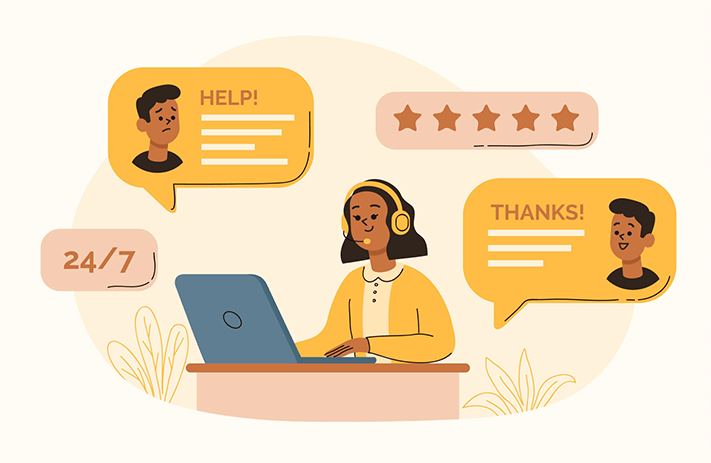
Click the button to start reading
9 Essential Tips for Creating an Elite Customer Service Team
Are you overwhelmed by the thought of building a customer service team from scratch? Or maybe you’re not sure where to start? Don’t worry, we got you covered.
Building a top-notch customer service team doesn’t have to be difficult. With the right strategy and plan in place, you can create a world-class customer service team that will keep your customers happy and coming back for more.
In this article, we’ll show you how to build a customer service team that will exceed your customers’ expectations. We’ll cover everything from finding the right people to training and managing your team.
By the end, you’ll have all the information you need to build a customer service team that’s second to none. So, let’s get started.

Build your customer service team for success…
Here’s a scenario: You’ve just launched your product and there’s a steady stream of customers coming in. But as the number of customer service inquiries grows, you quickly realize that you can’t handle it all yourself.
It’s time to build a customer service team. But where do you start? And how do you set up your team for success? Here are 9 helpful tips to help you build a customer service team that’s second to none:
1. Outline your customer service department’s vision and goals.
Have you ever had an experience where customer service was so good that it left a lasting impression on you? Maybe you called customer service with a problem and the representative went above and beyond to help you. Or maybe you had a great experience using a company’s live chat feature.
Whatever the case may be, those companies had a clear vision for their customer service departments. And that’s what you need to create a successful customer service team.
Here are some questions to ask yourself when outlining the vision for your customer service team:
- How do you want your customers to feel when they interact with your company?
- What type of customer service experience do you want to provide?
- What journey do you want your customers to take?
Answering these questions will help you create a clear vision for your customer service team. And that vision will be the foundation for everything else you do.
2. Recruit the right customer service representatives.
Now that you have a vision for your customer service team, it’s time to start recruiting the right people.
Finding talent can be extremely challenging, especially when you’re looking for customer service representatives. But there are a few things you can do to increase your chances of finding the right people.
Here are a few tips for recruiting customer service reps:
- Create a detailed job description: When you’re writing the job description, be sure to include information about the type of person you’re looking for.
- Include personality traits, skills, and experience levels that would make someone a successful customer service rep.
- Use employee referrals: Employee referrals are one of the best ways to find qualified candidates. And they’re also more likely to stick around longer than other employees.
The skills your looking for in an employee referral may be different than what you would typically find in a job posting. But that’s okay.
You’re looking for customer service reps who are passionate about providing great customer experience and are willing to go the extra mile for your customers.

3. Set the tone for customer interactions.
It would super tempting to write a long list of rules and regulations for your customer service team. But resist the urge.
Instead of creating a bunch of rules, set the tone for customer service interactions. How you want your team to interact with customers should be based on your company’s values.
For example, if one of your company values is “be helpful,” then your customer service team should be trained to provide helpful solutions to customer problems. So be sure to keep your company values in mind when setting the tone for customer interactions.
You might be thinking , “What exactly is tone?”
Tone is the way you communicate with someone. It’s the attitude and feeling that comes across in your words and actions. And the tone you set will be reflected in the way your team interacts with customers. So if you want your team to provide world-class customer service, be sure to set the tone accordingly.
Here are some common tones, that customer service teams can set:
- Friendly
- Empathetic
- Helpful
- Calm
- Enthusiastic
4. Teach your team active listening skills.
Active listening is a communication method that demands the listener to fully engage with the person speaking. This means giving your undivided attention to the person, and not interrupting them while they’re speaking.
It also means paraphrasing what the person has said, to ensure that you understand them correctly. And not jumping to conclusions or trying to fix the problem before fully understanding it.
Active listening is an essential skill for customer service representatives. And it’s something that needs to be taught and practiced.
Picture this : You’re on the phone with a customer service representative and you can tell they’re not really listening to you. They keep interrupting you and trying to fix the problem before you’ve had a chance to explain it. It’s frustrating, right?
Active listening is the opposite of that. When you’re an active listener, you give the customer your full attention. You let them finish explaining the problem before you start trying to solve it. This makes the customer feel valued and appreciated, and it helps you resolve the issue more effectively.
Here are some tips for teaching your team active listening skills:
- Encourage your team members to ask questions if they need clarification. This shows the customer that you’re interested in helping them and that you want to fully understand the problem.
- Ask open-ended questions to get more information from the customer.
- Empathize with the customer and let them know you understand how they feel.
- Paraphrase what the customer has said, to ensure that you understand them correctly.
- Avoid interrupting the customer while they’re speaking.
- Don’t jump to conclusions or try to fix the problem before fully understanding it.
You can also hold training sessions on active listening. During these sessions, role-play different customer service scenarios. This will give your team members a chance to practice active listening in a safe and controlled environment.
Teaching your team active listening skills will help them understand the customer’s issue and find a resolution more quickly. It will also help diffuse difficult situations and build trust with customers.

5. Help your team members identify their triggers.
We all have triggers–things that set us off and make us react in a negative way. It’s important to help your team members identify their triggers so they can be aware of them in customer service interactions.
If you can help your team members identify their triggers, they will be better equipped to deal with them in customer service interactions. They will also be able to take steps to avoid or manage situations that might trigger a reaction.
Below are common triggers and some tips for dealing with them:
Feeling ignored or dismissed
If you feel like the customer is not listening to you or taking you seriously, it’s important to stay calm and try to understand their perspective. It can be helpful to restate what the customer has said in your own words to show that you’re listening and trying to understand.
Feeling attacked or criticized
If the customer is being confrontational or critical, it’s important to stay calm and try not to take it personally. Try to understand why the customer is feeling this way and see if there’s anything you can do to help.
Feeling overwhelmed or stressed
If you’re feeling overwhelmed or stressed, it’s important to take a step back and take a deep breath. You might also want to try some relaxation techniques, such as progressive muscle relaxation or mindfulness meditation.
Being yelled at
If the customer is yelling, it’s important to stay calm and try to understand why they’re feeling this way. It can be helpful to restate what the customer has said in your own words to show that you’re listening and trying to understand. You might also want to offer to help the customer with their issue
Having to wait too long for a response
If you’re feeling impatient, it’s important to take a deep breath and remember that the customer is probably feeling just as frustrated as you are. Try to be understanding and empathetic.

6. Give your team the technical tools they need to succeed.
At its best, customer service is the glue that holds a business together. It’s the human element that can turn a one-time customer into a lifelong advocate. But delivering great customer service takes more than just having friendly representatives. It takes having the right tools in place so your team can do their job efficiently and effectively.
Think of your customer service team as surgeons. Would you want your surgeon operating on you with a rusty old scalpel that hasn’t been sharpened in years? Of course not! You want them to have the best tools available so they can do their job properly. The same goes for your customer service team.
Here are four essential tools your customer service team needs in order to be successful:
CRM system
A CRM (customer relationship management) system is a tool that helps businesses manage their interactions with current and potential customers. A good CRM system will help your customer service team keep track of customer inquiries and requests, issue resolutions, order history, and contact information. This information is important because it helps your team provide faster and better resolutions, prevent issues from falling through the cracks, and proactively reach out to customers before problems arise.
Live chat tool
A live chat tool allows your customers to get in touch with your customer service team in real-time via chat message rather than having to wait on hold or sending an email inquiry. This is important because it provides customers with a faster way to get answers to their questions or resolve their issues, which leads to happier customers! In addition, live chat also gives you the ability to collect valuable data about your customers’ needs and pain points so you can make improvements to your products or services.
Knowledge base (Essential information)
A knowledge base is essentially an online library of articles, FAQs, and other resources that your customer service team can refer to when they need help resolving an issue. This is important because it helps reduce the amount of time spent on each call or chat, which leads to higher efficiency and productivity for your team. In addition, a well-organized knowledge base can also help reduce instances of “support ticket creep”—when support tickets keep getting re-opened because the original issue was never fully resolved.
Reporting tools
A reporting tool allows you to track various metrics related to your customer service team’s performance, such as average resolution time, abandonment rate, first contact resolution rate, etc. This information is important because it helps you identify areas where your team needs improvement so you can make changes accordingly. It also helps you benchmark your team’s performance over time so you can see how they’re improving (or not).

7. Encourage your team to use positive language.
Have you heard of the science experiment with plants and the effects of positive language? There were two groups of plants both were treated equally, except for the words that were said to them.
One group was praised with positive words and the other group was scolded with negative words. The plants that were praised grew taller, had healthier leaves, and produced more flowers. The plants that were scolded had stunted growth, unhealthy leaves, and produced fewer flowers.
The same goes for your customer service team. When they use positive language, it has a positive effect on them, which in turn has a positive effect on their interactions with customers.
Here are some words and phrases to encourage your team to use:
- “That’s a great question!”
- “I’m happy to help you with that.”
- “Thank you for bringing that to our attention.”
- “I’m sorry to hear that you’re having trouble.”
- “Let me see if I can help you with that.”
- “Is there anything else I can help you with today?”
8. Teach your team how to de-escalate difficult situations.
Unfortunately, not every customer interaction is going to be pleasant. There will be times when customers are angry, upset, or just plain difficult to deal with. That’s why it’s important for your team to know how to de-escalate these types of situations.
Here are a few tips:
- Remain calm and avoid getting defensive.
- Empathize with the customer and try to see things from their perspective.
- Don’t make promises you can’t keep.
- Acknowledge when your company dropps the ball.
- Apologize if appropriate.
- Focus on finding a resolution rather than winning an argument.

9. Encourage your team to take breaks.
No one can be expected to be 100% all the time. There will be days when team members are struggling and that’s okay. What’s important is that you have a plan in place to support them so they can continue delivering great customer service.
After-all, happy team members lead to happy customers.
Here are a few ways you can support your team:
- Make sure they have access to mental health resources.
- Lead by example and practice self-care yourself.
- Encourage them to take breaks when they need it.
- Be understanding and flexible if they need to make adjustments to their schedule.
A word of caution: Don’t be too lenient with your team. Customer service can be a difficult job and you don’t want to end up with a team that’s burned out. Find a good balance between supporting your team and holding them accountable to their job responsibilities.
Bottom Line…
Sometimes when you’re in the weeds it’s easy to forget the forest. In order to build a successful customer service team, you need to have a clear vision, set goals, and put systems and processes in place to support your team. With the right foundation in place, you’ll be well on your way to building a world-class customer service team.
If your looking to keep your team organized and focused, you should check out Teamly’s intuitive project management software. Check us out today.
















